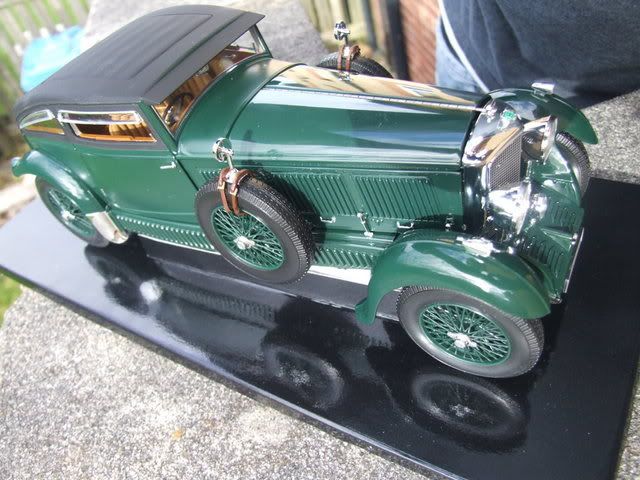well this finally made it

1930 Bentley Speed Six "Blue Train Special" some background on the model.
In 1930 the coachbuilders Gurney Nutting produced this fixed head coupe for capt Woolf Barnato,who was at the time Chairman of Bentley Motors. A stunning car that is truly unique,just one example with this body style was ever produced.This design is unusual as it features a third seat mounted "side-saddle" beneath the sloping roof.
Known as the "Blue Train Bentley",this Speed Six is one of the most famous Bentley's of all time.Its name is take from a famous challenge that took place in 1930 and saw Barnato race "Le Train Bleu" that ran the lenth of France between Cannes and Calais.
Whilst dinning on a friend's Yacht in Cannes,Barnato entered into a casual wager that he could not only race the Train to Calais in his Bentley Speed Six(it had been done before), he could in fact cross the channel to England before the train arrived in Calais.
Such was Barnato's pace at the wheel of his Speed Six that,despite a puncture and failing to find the fuel lorry he had arranged near Auxerre,he not only beat the train but also managed to arrive back in London four minutes before the train arrived in Calais,thus winning the £200 wager.(He was subsequently find the equivalent of £160 by the French authorities for an illegal motor race through France,which he failed to pay.)
This twist in the tale is that some now believe this car may not have been completed at the time of the race and it was another Speed Six owned by Barnato that took part in the epic run,but this unique Bentley will be forever known as the car that beat the Blue Train.
(A dramatisation on Woolf Barnato's own account of the Blue Train episode.)
|
Blue Train Special
Once upon an enchanted time, a sporty gentleman by the name of Captain Woolf Barnato was guest at a smart 1930's dinner party in Cannes.
Captain Barnato was a businessman of substance, a celebrated racing driver, and a noted bon vivant. No doubt there was fine cuisine and good company at the table that evening, but we might guess that he nevertheless was feeling a little restless…
Talk around the table had swung round to the topic of motor cars; in particular to an advertisement by a manufacturer of the day claiming that his machine had gone faster than the famous Blue Train express as it journeyed on its way from Cannes to the French Channel port of Calais.
Barnato smiled. He contended that just to go faster than the Blue Train was of no special merit. Why, at the wheel of his own Speed Six Bentley, he declared, he could arrive in England before The Blue Train reached Calais! That would indeed be a test of man and machine. Would he care to prove it? He would!
The next day, as at 5:45 PM The Blue Train steamed out of the station at Cannes. Captain Barnato, with one of his friends who had gallantly offered to act as a relief driver, took to the mighty Bentley and set off at the double.
From Lyons onwards they had to battle against heavy rain. At 4:20 AM, in Auxerre, they lost time searching for a refueling rendezvous. Through central France they hit fog, then shortly after Paris they had a burst tyre, requiring the use of their one and only spare. And yet, racing non-stop through the night along the bumpy, 1930's Routes Nationales, they reached the coast at 10:30 AM, sailed over to England on the cross-Channel packet, and were neatly parked outside The Conservative Club in St. James's Street, London, by 3:20 PM - four minutes before The Blue Train was to arrive in Calais!
Woolf Barnato, a millionaire sportsman, had a number of swashbuckling Bentleys specially built for him in the 1930's including a 61/2 litre, 3-seater coupe with coachwork by Gurney-Nutting. The redoubtable Captain Barnato was long an admirer of W.O. Bentley's engineering expertise and during the 1930's invested heavily in Bentley Motors, and was appointed its Chairman.
A distance of over 570 miles, having maintained an average speed of 43.43 mph. (Re-printed from the Spring 1995 Quest Magazine)
|
In truth the car that really did the race was a speed six le mans race car with a Mulliner saloon body.this blue train car was deliveried a couple of weeks later and named after the race.
now onto the model! The model really is beautiful and there is nice little details on it for example the leather strap used as the hinge for the boot and the tools in it.the engine is also massive! not as detailed as cmc or exoto but its nice enough.thankfully on this the wings and bonnet are metal!!! (yay!!

) and as on the blower my favourite part of the model is the door and bonnet hinges,i havent seen nicer hinges on another model before.
 more pics
more pics